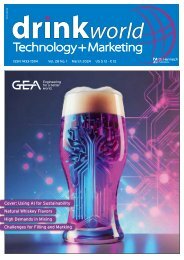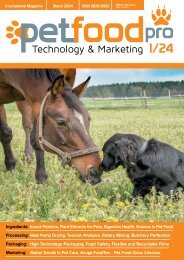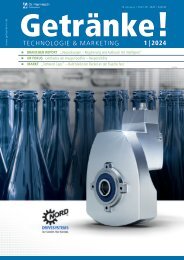drinkworld Technology + Marketing 1/2023
drinkworld Technology + Marketing is the leading magazine for the entire drinks industry worldwide. Feature articles and short communications cover the whole spectrum of processing, bottling, raw materials, logistics, packaging and marketing of beverages. We also report on special topics of regional interest and the trends in the beverage industries worldwide. Readers are executives and decision-makers in the brewing, dairy and mineral water industries, manufacturers of non-alcoholic drinks, wine growers and bottlers.
drinkworld Technology + Marketing is the leading magazine for the entire drinks industry worldwide. Feature articles and short communications cover the whole spectrum of processing, bottling, raw materials, logistics, packaging and marketing of beverages. We also report on special topics of regional interest and the trends in the beverage industries worldwide. Readers are executives and decision-makers in the brewing, dairy and mineral water industries, manufacturers of non-alcoholic drinks, wine growers and bottlers.
You also want an ePaper? Increase the reach of your titles
YUMPU automatically turns print PDFs into web optimized ePapers that Google loves.
Editorial<br />
Keeping Milk Fresher for Longer<br />
When I was a kid, I lived for a while<br />
on a small farm. Milking the cows was<br />
hard work, but drinking the warm<br />
and creamy milk straightaway was<br />
a reward, nothing added, nothing<br />
taken away. Nowadays that would be<br />
seriously frowned upon. Too much fat<br />
or potential for dirt and disease are<br />
only two of the dangers!<br />
Half a century later, I am still here and<br />
in reasonable health! Many of the main<br />
challenges with milk production is in<br />
distribution and keeping it fresher for<br />
longer. In times where more people live<br />
in cities than on farms and during the<br />
pandemic, where visits to public places<br />
were kept to an absolute minimum,<br />
stockpiling foods and drinks was felt to<br />
be a necessity; so this food needs to be<br />
safe for as long as possible.<br />
Milk has traditionally been pasteurised<br />
using heat treatment to reduce<br />
microorganisms and bacteria or<br />
sterilised to remove them completely.<br />
Pasteurised milk lasts longer if kept<br />
refrigerated, whereas sterilised<br />
products can be kept for longer and at<br />
room temperature. Taste differences to<br />
fresh milk meant it took a long time for<br />
dairy drinks to become acceptable.<br />
As health concerns became more<br />
publicised, the move towards lower<br />
fat content was accepted, where<br />
separation technology removed the<br />
cream. More recently organic milk has<br />
become more popular, as well as nondairy<br />
milk drinks using grains. This<br />
initially came about as an alternative<br />
and protest against the hormone<br />
treatment for cows to increase yield.<br />
In the meantime there are several<br />
different processing options available to<br />
reduce contamination in food and dairy<br />
products. These include use of radio<br />
frequency and microwave technologies,<br />
as well as MST and raslysation.<br />
Microsecond technology (MST) has the<br />
ability to deliver the taste and nutrition<br />
of HTST pasteurisation and the shelflife<br />
benefits of UHT but with better<br />
taste and nutritional benefits as well as<br />
significant cost savings.<br />
Raslysation is a non-thermal treatment<br />
that uses UV-light combined with a<br />
special flow pattern. It is a patented<br />
technology from Denmark which<br />
can treat the vast majority of liquid<br />
products regardless of how opaque or<br />
visocus they are independent of the<br />
temperature to achieve the desired<br />
Ian D. Healey<br />
Editor-in-Chief<br />
Photo: BB<br />
microbial reduction. “UV is as effective<br />
as heat against foodborner pathogen<br />
and spoilage organisms, but it requires<br />
less energy and water, has no effect on<br />
taste and flavor and actually extends the<br />
shelf-life of the liquids,“ states Tatiana<br />
Koutchema, PhD, Research Scientist for<br />
Agriculture and Agri-Food Canada.<br />
Last year I was in Chicago for a few days.<br />
I found it fascinating to visit the Lincoln<br />
Park Zoo and watch city children learning<br />
where milk really comes from. I’m sure<br />
many readers can tell many stories all<br />
around the food and beverage industry!<br />
Cheers<br />
www.drink-tm.com<br />
If you like it – subscribe!<br />
<strong>drinkworld</strong> <strong>Technology</strong> + <strong>Marketing</strong> · March <strong>2023</strong> 3


















